Abdul Qadim Haqq: 25 Years of Techno Art

Abdul Qadim Haqq sits in a conference room on the top floor of Underground Resistance’s Submerge headquarters on East Grand Blvd. in Detroit, while classic Detroit techno sounds resonate through the wall. An Underground Resistance affiliate is playing a mix in a nearby room. Floors below lies the famed Submerge techno museum, which houses priceless Detroit techno memorabilia including Haqq’s early illustrations. It is a collection visited by techno fans all over the world. Today, Haqq is celebrating his outlet Third Earth Visual Arts’ 25th anniversary with a book he printed just hours earlier.
Titled 1989-2014: 25 Years of Techno Art, the retrospective contains a vast collection of Haqq’s illustrated work, which ranges from portraits of Detroit techno artists to Detroit techno label art to sci-fi anomalies. One can find work Haqq has created for Carl Craig, Model 500, Galaxy 2 Galaxy, Underground Resistance, Rick Wade and more. A veritable dream coffee table book for any Detroit techno admirer, it serves as a visual encyclopedia of the music’s conception and evolution over time, as seen through Haqq’s eyes and mind.
I always felt like there was a connection between techno and science fiction [from the moment] I first heard techno, because it sounded like it was from outer space.
“This [October] is the month I started Third Earth Visuals 25 years ago,” he explains of Third Earth’s origins. “I was an art student at CCS [College for Creative Studies, Detroit]. It was originally the Center for Creative Studies, which is what I’ll always know it as. We got our start when Derrick May from Transmat asked us to do artwork for his label. We started doing work there and he liked it, so he let us have a studio in the basement at Metroplex, which he arranged with Juan Atkins. Third Earth Visuals was [originally] four art students, but we all went different paths and I’m the only one who stuck with it for the past 25 years.”
Haqq majored in graphic illustration at CCS, his love for fantasy art inspired by childhood pastimes such as watching sci-fi and Japanese animation. “Japanese cartoons were all I watched when I was a kid, like Speed Racer, Battle of the Planets and Robotech,” says Haqq. “I watched them constantly; I never missed an episode.”
As he grew older, he was naturally drawn to techno’s futuristic, otherworldly sound – a style of music blossoming in Detroit while Haqq attended college. “I always felt like there was a connection between techno and science fiction [from the moment] I first heard techno, because it sounded like it was from outer space,” he says. “A lot of [techno] styles sounded really futuristic and extraterrestrial. It was easy for me to always make that connection and get those different visualizations and imagery [for my art].”
There was just so much creativity and promise back then. We were all young and we just didn’t know any better.
Over the last 25 years, Haqq’s illustrations have become some of the most revered techno art in the world. A humble man, he doesn’t talk much about the importance behind many of his pieces, which include Carl Craig’s famed Planet E robot character “E-2000” and Underground Resistance’s “Analog Assassin.” He simply shrugs and reflects upon the conceptualization of Detroit techno. “When you’re that young, you really don’t know what’s going on,” he muses. “I was pretty oblivious to [the movement]. I just took it as, ‘Hey, we’ve got a studio where we can do some art and listen to some cool music!’ I didn’t really think of the legacy and the historical ramifications or cultural things. I didn’t even take care of my early paintings. They weren’t preserved and were lost to time.”
He calls Detroit techno’s early development the “golden age.” “I don’t know of a better time as far as the music that I can think of here in Detroit,” he says. “There was just so much creativity and promise back then. We were all young and we just didn’t know any better.”
Haqq will listen to techno and paint or draw based on how the music makes him feel, sometimes in a live setting. He lets the sound inspire him. “It’s just a free-flow thought creativity kind of thing,” he describes. “Usually I get into a zone. I can focus everything out and just do my paintings.”
With his 25th anniversary silver book on the table, Haqq smiles proudly, taking us through some of his finer pieces as he flips through the pages.
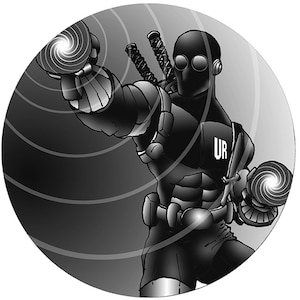
The Analog Assassin
Mike [Banks] told me he needed a ninja-type character. I started listening to the music [on The Analog Assassin] and it sounded really sweet. This is what I came up with – this guy isn’t a regular ninja because he uses sound and sonic guns and different sonic weapons.
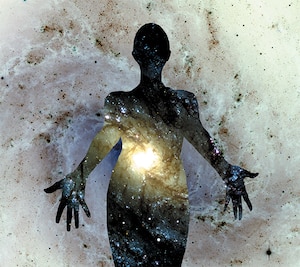
Galaxy 2 Galaxy
I always thought Galaxy 2 Galaxy was a really deep concept. I was thinking of matter, antimatter… a feminine aspect of the universe kind of thing. So you have a positive and a negative aspect—it’s all encompassing.
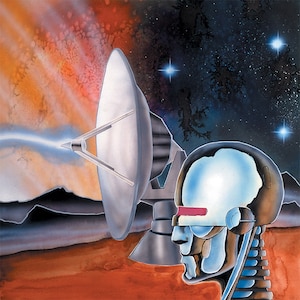
Model 500
I thought to base [this piece] off of a robot because that’s the way I felt when I heard this music. I thought of a Model 500 as a robot series and them fighting a battle on a remote distant world. It’s no particular planet.
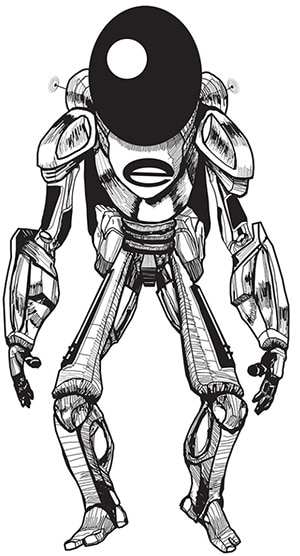
E-2000
Carl Craig came up to me and wanted to do something new that hadn’t been seen before, so we came up with this robot, and then we did a painting from it for the album Intergalactic Beats. It was always one of the symbols of early Planet E. [There is no face because] originally there was supposed to be a human being inside the dome. The dome would lift up and a human being would be inside as a pilot.

Knights of the Jaguar
That’s one of the biggest techno records of all time. [This piece is] based off of Aztec mythology. One of the older DJs back in the day, Rolando, he was from a Mexican heritage so we based a whole concept off of that called “The Aztec Mystic.” I studied Aztec mythology and different cults… the jaguar is [based off of] one of the warrior cults.

Timeline
I based the concept off of time travel and going back into time. In my brain, they went far enough back in time to influence Egyptian civilization.
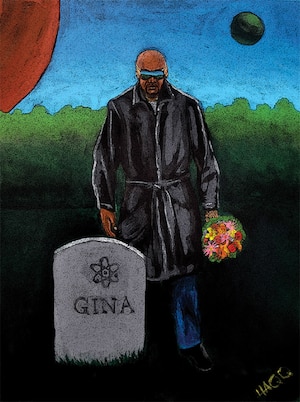
Rick Wade
Rick Wade was always known as a ladies man, so I sort of had a concept about all of these different kinds of women being attracted to him. One was sort of an android cyborg and one was green, but they all liked Rick Wade! That’s based off of a short story written by a Japanese director called Requiem for a Machine Soul. An android got disassembled because she showed emotion, so Rick Wade went to the robot graveyard to put flowers on her grave. The android’s name was Gina. It was a really deep story – we really enjoyed it. It was one of the high-points of my career.

